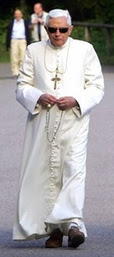Though (in the 1962 Breviary) this is a feria, I could not let this day pass without praising Our Lady of Guadalupe, Empress of the Americas, Mother of the True God, who appeared in Mexico in 1531 to St Juan Diego Cuauhtlatoatzin, impressing her sacred image on his tilma, that frail rough garment of cactus fibre, in a manner inexplicable to science, and which has survived fire and acid and a bomb to remain over 470 years later the great miraculous image of the Americas; and who by her wondrous manifestation so moved all hearts as to convert the peoples of the New World to Christ. The modern second readings (in Latin and Spanish) for the feasts of St Juan Diego and Our Lady of Guadalupe are available from the website of the Basilica of Guadalupe.

If you want a stunning piece of music to play in Our Lady's honour, I thoroughly recommend Chanticleer's CD of Matins of Our Lady of Guadalupe, including powerful Mexican Baroque settings of responsories and hymns by Ignatio de Jerusalem (1707-1769), and two thrilling paraliturgical villancicos by Manuel de Zumaya (c.1678-1755). It even has the three historical lessons from the proper Office of Our Lady of Guadalupe, as approved by Benedict XIV, that great Pope (see here for these lessons); who, upon seeing a faithful copy of the Holy Tilma, exclaimed Non fecit taliter omni nationi - "She hath not wrought thusly in every nation" (cf. Ps 147:9). Unfortunately I didn't bring this CD with me, nor uploaded it to my iPod. :-(
******
Since today is a feria here in Australia, I had a different pleasure while saying Matins and Lauds: to kneel and pray the preces. These are fine prayers, and I wish they were in the Office every day, as they always were in the Traditional Benedictine, and often in the Dominican Breviary (as a Kyrie and Pater noster before the collect at each Hour). It was unfortunate that the breviary reform of 1955 cut down on the Matins lessons and preces; I understand many traditionally minded clergy (such as those under Bishop Rifan in the Apostolic Administration in Campos) still read these, on the principle that one can hardly be criticised for saying more of the Office than is strictly required.
As it is, I have taken up – and thoroughly recommend – the traditional practice of saying a Pater and Ave before each Hour (except at Lauds if joined to Matins, nor at Compline, when one says them afterward), and a Pater afterward if no other Hour is to be said straightaway (one also says a Credo before Matins, before Prime, and after Compline). This helps one get ready for prayer, and guards one's heart from running off heedlessly afterwards: St Ignatius Loyola encourages this when he recommends, prior to making meditation, that one lift one's heart up to God "for the space of a Pater noster".
One of the things I most miss from the new Office is the absence of intercessions before the collect of Lauds and Vespers. Though they are rather paraphrased than translated into English, even so they are rich, and in the Latin quite excellent. Earlier I decided to read this morning's intercessions from the new Office:
Dominum nostrum Jesum Christum, fratres carissimi, exoremus, qui in sua misericordia nos visitat, lætamque vocem iteremus: Veni, Domine Jesu.Qui de sinu Patris egressus, venisti ut carnis nostræ vestimentum indueres, – libera quod perierat naturæ vitiatæ contagio.Qui venturus, in electis agnosceris gloriosus, – nunc veniens, in peccatoribus clemens semper et pius inveniaris.Gloriantes in laude tua, Christe Domine, – visita nos in salutari tuo.Qui nos jam eduxisti in lucem per fidem, – fac nos justitia tua pro dignis operibus tibi placitos.Pater noster...Omnipotens Deus, qui nos præcipis iter Christo Domino præparare, concede propitius, ut nullis infirmitatibus fatigemur, qui cælestis medici consolantem præsentiam sustinemus. Per Dominum...
Must go to Mass now!








No comments:
Post a Comment